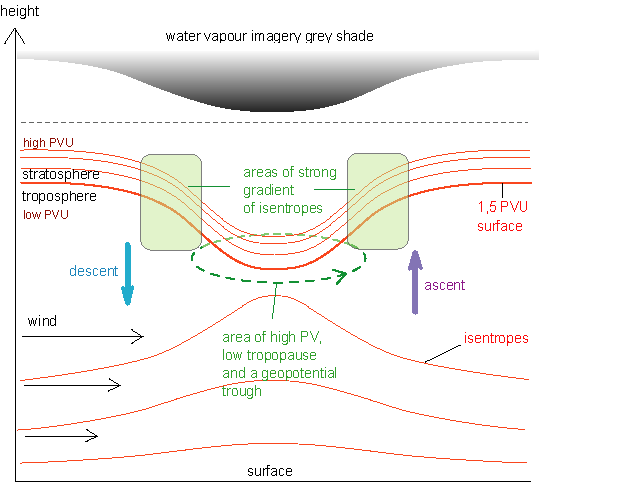Potential Vorticity
For additional information look at http://www.zamg.ac.at/docu/Manual/SatManu/main.htm, Basics and http://oiswww.eumetsat.org/WEBOPS/msg_interpretation/index.html.On an isentropic surface the potential vorticity PV is a product of absolute vorticity and static stability. One of the most important application of PV is defining the height of the tropopause.
Potential vorticity and tropopause
PV is counted in PVU (PV units, 10-6m-2s-1K kg-1). As the static stability is higher in stratosphere than in troposphere, also PV is higher there. Typical changes of PVU around the tropopause is from 1 (tropospheric air) to 4 (stratospheric air) PVU. PVU depends on the latitude; in the mid-latitude areas the height field of 1,5 or 2 PVU is commonly defined as the dynamical tropopause.
Positive potential vorticity anomalies are by definition areas, where PV is higher than in its surroundings.
The next picture presents an idealized cross section of an positive PV anomaly that is moving with the upper wind. The wind speed increases with height. 1,5 PVU surface separates the very stable stratosphere, where the isentropes are close to each other, and the much less stable troposphere. Ahead of the PV anomaly there is ascent, behind it descent. In the water vapour image the anomaly appears as a dark, roundish area.

Please, fill in following the sentences! If you want to start from scratch:
1. Local maximum minimum maximum in brightness temperature in water vapour channels.
2. Local maximum minimum minimum in the height of tropopause.
3. Local maximum minimum minimum in geopotential.
4. Local maximum minimum maximum of isentropic values.
5. Local cyclonic anticyclonic cyclonic circulation.